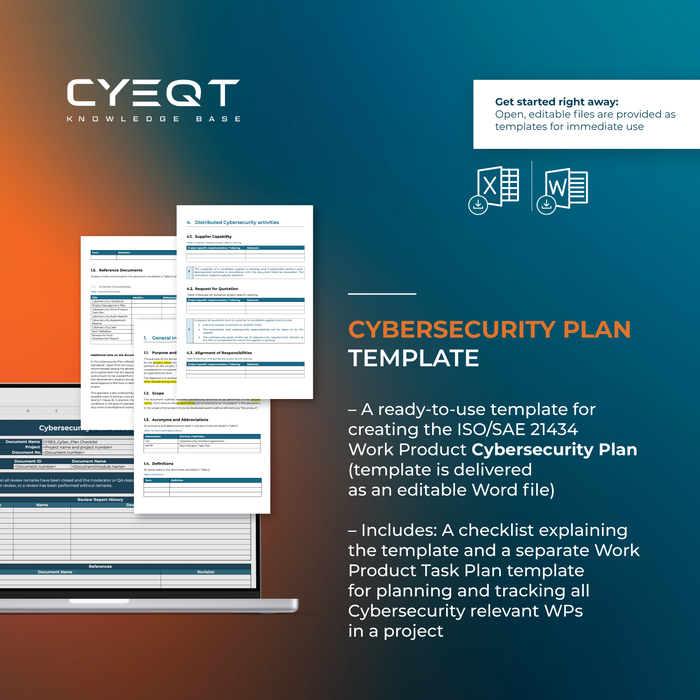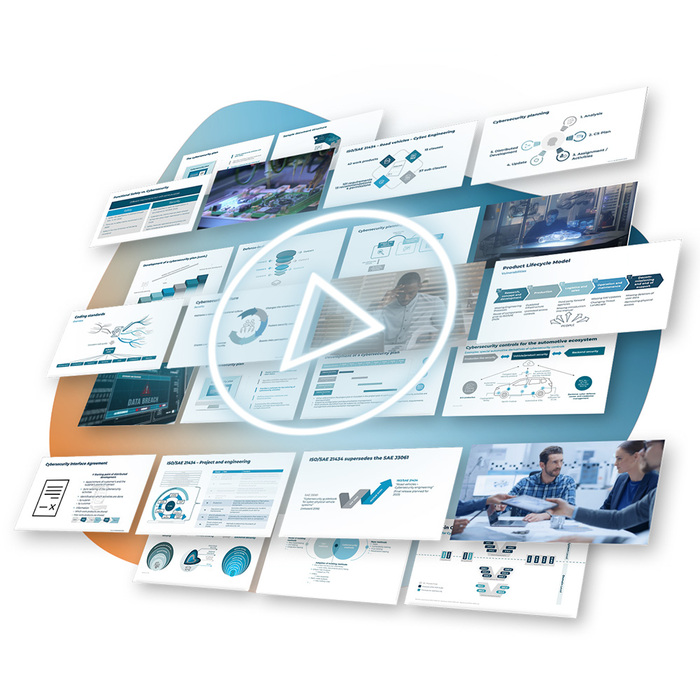

Do you need to apply ISO/SAE 21434 to your vehicle development project? If so, the Work Product Cybersecurity Plan, which compiles the central overview/documentation of all cybersecurity activities in a structured manner, is one of your most important tasks to tackle.
This is where our new customizable Cybersecurity Plan template, including a checklist and a Cybersecurity Work Product Task Plan, provides support.
With our carefully crafted template, which is based on a vast range of practical experience, you can ensure compliance with ISO/SAE 21434 and receive a simple and comprehensive template to set up your own Cybersecurity Plan for your development project.
>> LEARN MORE
As an automotive specialist, you know that with the ongoing technological development of the automobile, automotive cybersecurity is becoming a challenge for the entire supply chain.
It is not only a matter of building up the necessary knowledge about automotive cybersecurity (for example, through training and learning courses), but also of providing the corresponding evidence of this knowledge.
For example, ISO/SAE 21434 Road Vehicles - Cybersecurity Engineering and UN Regulation No. 155 set out very specific evidence obligations in terms of automotive cybersecurity competencies.
This is where the ACP Framework comes in. The ACP Framework stands for a holistic automotive cybersecurity competence management consisting of knowledge provision and the corresponding certification of persons (in cooperation with TÜV Rheinland as certification partner).
Here, on the CYEQT Knowledge Base learning platform (former CYRES Academy), you will find the training courses (ACP Level 1 and ACP Level 2), related official ACP certifications, as well as advanced learning video courses and informational materials.
As a self-service platform, you can directly purchase the products via the checkout function. For corporate inquiries please contact us.

Goodbye standard training courses. Raise the curtain on our new role-based video courses 📺 Fundamental Principles of Automotive Cybersecurity - tailored to the most important functions and roles in vehicle development.
Based on the ACP Framework competency model, we have compiled the basic knowledge content on automotive cybersecurity and its influence on the respective work area. Each video course is tailored to a specific key role in the industry.
You can currently find the following role bundle video courses online on this platform for immediate access:
- Project Management
- Sales/Purchasing
- Quality
- Testing
- Hardware Engineering
- Software Engineering
- Systems Engineering
- Industrial Engineering
Whether you're steering projects, navigating sales, ensuring quality, or engineering the intricate components, these bundles equip you with the knowledge essential for fortifying automotive cybersecurity.
>> LEARN MORE


As part of our commitment to the industry in bringing new applicable knowledge and supporting companies with UN Regulation No. 155 compliance, in addition to our usual daily consulting business, we launched the highly anticipated ISO/SAE 21434:2021 Workbook.
It is the world's first ISO/SAE 21434:2021 Workbook officially licensed by ISO. The ISO/SAE 21434:2021 Workbook provides practical application of the automotive cybersecurity standard.
- all work products (and corresponding requirements, recommendations and permissions) of ISO/SAE 21434:2021 (“First Edition”) – officially licensed by ISO
- Field-tested templates for key work products, such as Cybersecurity Plan, CIA, Item Definition, Cybersecurity Concept, TARA, and more
- Expert interviews, background information, explanations with a practical perspective across the automotive value chain.
Utilizing our customizable Word and Excel Item Definition files, teams can guarantee that their Item definition is exhaustive, organized, and compliant with the ISO/SAE 21434 standard, thus enhancing the cybersecurity in vehicles.
>> LEARN MORE


Participation in the video course (ACP Level 1 or ACP Level 2) includes a Certificate of Attendance and qualifies you (exactly like the live training) for the subsequent certification examination with TÜV Rheinland Qualified Certification.
>> LEARN MORE

This learning platform is a self-service platform. By entering the data for an order, a new account is registered and access to the content is assigned to this newly opened account (i.e. buyer = participant/user of the training content).
Do you want another person in your organization/team to receive the purchased content (training/video)? Then you have the possibility to edit the created account after the ordering process and assign it to another person (change email address).
As a buyer, do you want to purchase content for multiple people at once? This works by purchasing voucher codes, which the individual users then redeem on their own.
For all custom inquiries regarding video trainings, templates/publications, as well as trainings and certifications, please email us at: learn@cyeqt.com





